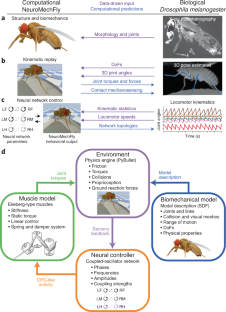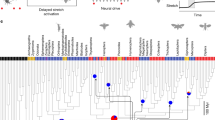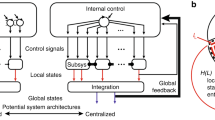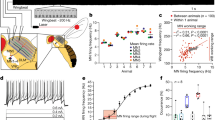Abstract
Animal behavior emerges from an interaction between neural network dynamics, musculoskeletal properties and the physical environment. Accessing and understanding the interplay between these elements requires the development of integrative and morphologically realistic neuromechanical simulations. Here we present NeuroMechFly, a data-driven model of the widely studied organism, Drosophila melanogaster. NeuroMechFly combines four independent computational modules: a physics-based simulation environment, a biomechanical exoskeleton, muscle models and neural network controllers. To enable use cases, we first define the minimum degrees of freedom of the leg from real three-dimensional kinematic measurements during walking and grooming. Then, we show how, by replaying these behaviors in the simulator, one can predict otherwise unmeasured torques and contact forces. Finally, we leverage NeuroMechFly’s full neuromechanical capacity to discover neural networks and muscle parameters that drive locomotor gaits optimized for speed and stability. Thus, NeuroMechFly can increase our understanding of how behaviors emerge from interactions between complex neuromechanical systems and their physical surroundings.
This is a preview of subscription content, access via your institution
Access options
Access Nature and 54 other Nature Portfolio journals
Get Nature+, our best-value online-access subscription
$29.99 / 30 days
cancel any time
Subscribe to this journal
Receive 12 print issues and online access
$259.00 per year
only $21.58 per issue
Buy this article
- Purchase on Springer Link
- Instant access to full article PDF
Prices may be subject to local taxes which are calculated during checkout






Similar content being viewed by others
Data availability
Kinematic data and 3D pose estimations for walking behavior are available at https://doi.org/10.7910/DVN/Y3TAEC, and kinematic data and 3D pose estimations for grooming behavior are available at https://dataverse.harvard.edu/dataverse/DeepFly3D
Code availability
The code required to reproduce the experiments described here can be obtained as a Code Ocean capsule (https://codeocean.com/capsule/2418941/tree/v1, ref. 87). Code and documentation for developers are available in GitHub under an Apache 2.0 license (https://github.com/NeLy-EPFL/NeuroMechFly and https://nely-epfl.github.io/NeuroMechFly).
References
Chiel, H. J. & Beer, R. D. The brain has a body: adaptive behavior emerges from interactions of nervous system, body and environment. Trends Neurosci. 20, 553–557 (1997).
Webb, B. A framework for models of biological behaviour. Int. J. Neural Syst. 9, 375–381 (1999).
Pearson, K., Ekeberg, Ö. & Büschges, A. Assessing sensory function in locomotor systems using neuro-mechanical simulations. Trends Neurosci. 29, 625–631 (2006).
Prilutsky, B. I. & Edwards, D. H. (eds) Neuromechanical Modeling of Posture and Locomotion (Springer, 2015).
Seth, A. et al. OpenSim: simulating musculoskeletal dynamics and neuromuscular control to study human and animal movement. PLoS Comput. Biol. 14, e1006223 (2018).
Einevoll, G. T. et al. The scientific case for brain simulations. Neuron 102, 735–744 (2019).
Sigvardt, K. A. & Miller, W. L. Analysis and modeling of the locomotor central pattern generator as a network of coupled oscillators. Ann. NY Acad. Sci. 860, 250–265 (1998).
Lansner, A., Hellgren Kotaleski, J. & Grillner, S. Modeling of the spinal neuronal circuitry underlying locomotion in a lower vertebrate. Ann. NY Acad. Sci. 860, 239–249 (1998).
Ijspeert, A. J. A connectionist central pattern generator for the aquatic and terrestrial gaits of a simulated salamander. Biol. Cybern. 84, 331–348 (2001).
Rybak, I. A., Dougherty, K. J. & Shevtsova, N. A. Organization of the mammalian locomotor CPG: review of computational model and circuit architectures based on genetically identified spinal interneurons (1,2,3). eNeuro 2, ENEURO.0069-15.2015 (2015).
Ekeberg, Ö., Blümel, M. & Büschges, A. Dynamic simulation of insect walking. Arthropod Struct. Dev. 33, 287–300 (2004).
Toth, T. I., Schmidt, J., Büschges, A. & Daun-Gruhn, S. A neuro-mechanical model of a single leg joint highlighting the basic physiological role of fast and slow muscle fibres of an insect muscle system. PLoS ONE 8, e78247 (2013).
Toth, T. I., Grabowska, M., Schmidt, J., Büschges, A. & Daun-Gruhn, S. A neuro-mechanical model explaining the physiological role of fast and slow muscle fibres at stop and start of stepping of an insect leg. PLoS ONE 8, e78246 (2013).
Schilling, M., Hoinville, T., Schmitz, J. & Cruse, H. Walknet, a bio-inspired controller for hexapod walking. Biol. Cybern. 107, 397–419 (2013).
Szczecinski, N. S., Brown, A. E., Bender, J. A., Quinn, R. D. & Ritzmann, R. E. A neuromechanical simulation of insect walking and transition to turning of the cockroach Blaberus discoidalis. Biol. Cybern. 108, 1–21 (2014).
Proctor, J., Kukillaya, R. & Holmes, P. A phase-reduced neuro-mechanical model for insect locomotion: feed-forward stability and proprioceptive feedback. Philos. Trans. A Math. Phys. Eng. Sci. 368, 5087–5104 (2010).
Szczecinski, N. S., Martin, J. P., Bertsch, D. J., Ritzmann, R. E. & Quinn, R. D. Neuromechanical model of praying mantis explores the role of descending commands in pre-strike pivots. Bioinspir. Biomim. 10, 065005 (2015).
Guo, S., Lin, J., Wöhrl, T. & Liao, M. A neuro-musculo-skeletal model for insects with data-driven optimization. Sci. Rep. 8, 2129 (2018).
Szigeti, B. et al. Openworm: an open-science approach to modeling Caenorhabditis elegans. Front. Comput. Neurosci. 8, 137 (2014).
Izquierdo, E. J. & Beer, R. D. From head to tail: a neuromechanical model of forward locomotion in Caenorhabditis elegans. Philos. Trans. R. Soc. Lond. B Biol. Sci. 373, 1758 (2018).
Loveless, J., Lagogiannis, K. & Webb, B. Modelling the mechanics of exploration in larval Drosophila. PLoS Comput. Biol. 15, e1006635 (2019).
Merel, J. et al. Deep neuroethology of a virtual rodent. In Proceedings of the International Conference on Learning Representations https://openreview.net/forum?id=SyxrxR4KPS (2020).
Seeds, A. M. et al. A suppression hierarchy among competing motor programs drives sequential grooming in Drosophila. eLife 3, e02951 (2014).
Pavlou, H. J. & Goodwin, S. F. Courtship behavior in Drosophila melanogaster: towards a ‘courtship connectome’. Curr. Opin. Neurobiol. 23, 76–83 (2013).
Fry, S. N., Sayaman, R. & Dickinson, M. H. The aerodynamics of free-flight maneuvers in Drosophila. Science 300, 495–498 (2003).
Mendes, C. S. et al. Quantification of gait parameters in freely walking wild type and sensory deprived Drosophila melanogaster. eLife 2, e00231 (2013).
Wosnitza, A. et al. Inter-leg coordination in the control of walking speed in Drosophila. J. Exp. Biol. 216, 480–491 (2013).
Pick, S. & Strauss, R. Goal-driven behavioral adaptations in gap-climbing Drosophila. Curr. Biol. 15, 1473–1478 (2005).
Pereira, T. D. et al. Fast animal pose estimation using deep neural networks. Nat. Methods 16, 117–125 (2019).
Mathis, A. et al. DeepLabCut: markerless pose estimation of user-defined body parts with deep learning. Nat. Neurosci. 21, 1281–1289 (2018).
Günel, S. et al. DeepFly3D, a deep learning-based approach for 3D limb and appendage tracking in tethered, adult Drosophila. eLife 8, e48571 (2019).
Gosztolai, A. et al. LiftPose3D, a deep learning-based approach for transforming two-dimensional to three-dimensional poses in laboratory animals. Nat. Methods 18, 975–981 (2021).
Jenett, A. et al. A GAL4-driver line resource for Drosophila neurobiology. Cell Rep. 2, 991–1001 (2012).
Seelig, J. D. et al. Two-photon calcium imaging from head-fixed Drosophila during optomotor walking behavior. Nat. Methods 7, 535–540 (2010).
Maimon, G., Straw, A. D. & Dickinson, M. H. Active flight increases the gain of visual motion processing in Drosophila. Nat. Neurosci. 13, 393–399 (2010).
Chen, C. et al. Imaging neural activity in the ventral nerve cord of behaving adult Drosophila. Nat. Commun. 9, 4390 (2018).
Hermans, L. et al. Long-term imaging of the ventral nerve cord in behaving adult Drosophila. Preprint at https://doi.org/10.1101/2021.10.15.463778v1 (2021).
Phelps, J. S. et al. Reconstruction of motor control circuits in adult Drosophila using automated transmission electron microscopy. Cell 184, 759–774 (2021).
Scheffer, L. K. et al. A connectome and analysis of the adult Drosophila central brain. eLife 9, e57443 (2020).
Isakov, A. et al. Recovery of locomotion after injury in Drosophila melanogaster depends on proprioception. J. Exp. Biol. 219, 1760–1771 (2016).
Ramdya, P. et al. Climbing favours the tripod gait over alternative faster insect gaits. Nat. Commun. 8, 14494 (2017).
Coumans, E. Bullet physics simulation. In ACM SIGGRAPH 2015 Courses https://doi.org/10.1145/2776880.2792704 (2015).
Soler, C., Daczewska, M., Da Ponte, J. P., Dastugue, B. & Jagla, K. Coordinated development of muscles and tendons of the Drosophila leg. Development 131, 6041–6051 (2004).
Sink, H. Muscle Development in Drosophila (Springer, 2006).
Cruse, H., Dürr, V. & Schmitz, J. Insect walking is based on a decentralized architecture revealing a simple and robust controller. Philos. Trans. A Math. Phys. Eng. Sci. 365, 221–250 (2007).
Loper, M., Mahmood, N., Romero, J., Pons-Moll, G. & Black, M. J. SMPL: a skinned multi-person linear model. ACM Trans. Graphics 34, 248 (2015).
Zuffi, S., Kanazawa, A., Jacobs, D. W. & Black, M. J. 3D menagerie: modeling the 3d shape and pose of animals. In Proceedings of the IEEE Conference on Computer Vision and Pattern Recognition 6365–6373 (2017).
Li, S. et al. Deformation-aware unpaired image translation for pose estimation on laboratory animals. In Proceedings of the IEEE/CVF Conference on Computer Vision and Pattern Recognition 13158–13168 (2020).
Mu, J., Qiu, W., Hager, G. D. & Yuille, A. L. Learning from synthetic animals. In Proceedings of the IEEE/CVF Conference on Computer Vision and Pattern Recognition 12386–12395 (2020).
Bolaños, L. A. et al. A three-dimensional virtual mouse generates synthetic training data for behavioral analysis. Nat. Methods 18, 378–381 (2021).
Watson, J. T., Ritzmann, R. E., Zill, S. N. & Pollack, A. J. Control of obstacle climbing in the cockroach, Blaberus discoidalis. I. Kinematics. J. Comp. Physiol. A Neuroethol. Sens. Neural Behav. Physiol. 188, 39–53 (2002).
Frantsevich, L. & Wang, W. Gimbals in the insect leg. Arthropod Struct. Dev. 38, 16–30 (2009).
Bender, J. A., Simpson, E. M. & Ritzmann, R. E. Computer-assisted 3D kinematic analysis of all leg joints in walking insects. PLoS ONE 5, e13617 (2010).
Zill, S. N. et al. Effects of force detecting sense organs on muscle synergies are correlated with their response properties. Arthropod Struct. Dev. 46, 564–578 (2017).
Cofer, D., Cymbalyuk, G., Heitler, W. J. & Edwards, D. H. Neuromechanical simulation of the locust jump. J. Exp. Biol. 213, 1060–1068 (2010).
Moore, R. J. D. et al. Fictrac: a visual method for tracking spherical motion and generating fictive animal paths. J. Neurosci. Methods 225, 106–119 (2014).
Azevedo, A. W. et al. A size principle for recruitment of Drosophila leg motor neurons. eLife 9, e56754 (2020).
Fuchs, E., Holmes, P., Kiemel, T. & Ayali, A. Intersegmental coordination of cockroach locomotion: adaptive control of centrally coupled pattern generator circuits. Front. Neural Circuits 4, 125 (2011).
Mantziaris, C. et al. Intra-and intersegmental influences among central pattern generating networks in the walking system of the stick insect. J. Neurophysiol. 118, 2296–2310 (2017).
Schilling, M. & Cruse, H. Decentralized control of insect walking: a simple neural network explains a wide range of behavioral and neurophysiological results. PLoS Comput. Biol. 16, e1007804 (2020).
Ijspeert, A. J., Crespi, A., Ryczko, D. & Cabelguen, J. From swimming to walking with a salamander robot driven by a spinal cord model. Science 315, 1416–1420 (2007).
Ekeberg, Ö. A combined neuronal and mechanical model of fish swimming. Biol. Cybern. 69, 363–374 (1993).
Daun-Gruhn, S. A mathematical modeling study of inter-segmental coordination during stick insect walking. J. Comput. Neurosci. 30, 255–278 (2011).
DeAngelis, B. D., Zavatone-Veth, J. A. & Clark, D. A. The manifold structure of limb coordination in walking Drosophila. eLife 8, e46409 (2019).
Oliveira, M. et al. Multi-objective parameter CPG optimization for gait generation of a quadruped robot considering behavioral diversity. In 2011 IEEE/RSJ International Conference on Intelligent Robots and Systems 2286–2291 (2011).
Deb, K., Pratap, A., Agarwal, S. & Meyarivan, T. A fast and elitist multiobjective genetic algorithm: NSGA-II. IEEE Trans. Evolutionary Computation 6, 182–197 (2002).
Strauss, R. & Heisenberg, M. Coordination of legs during straight walking and turning in Drosophila melanogaster. J. Comp. Physiol. A 167, 403–412 (1990).
Szczecinski, N. S., Bockemühl, T., Chockley, A. S. & Büschges, A. Static stability predicts the continuum of interleg coordination patterns in Drosophila. J. Exp. Biol. 221, jeb189142 (2018).
Vincent, J. F. & Wegst, U. G. Design and mechanical properties of insect cuticle. Arthropod Struct. Dev. 33, 187–199 (2004).
Flynn, P. C. & Kaufman, W. R. Mechanical properties of the cuticle of the tick Amblyomma hebraeum (Acari: Ixodidae). J. Exp. Biol. 218, 2806–2814 (2015).
Kimura, K., Minami, R., Yamahama, Y., Hariyama, T. & Hosoda, N. Framework with cytoskeletal actin filaments forming insect footpad hairs inspires biomimetic adhesive device design. Commun. Biol. 3, 272 (2020).
Takahashi, H. et al. Maximum force capacity of legs of a fruit fly during landing motion. In 19th International Conference on Solid-State Sensors, Actuators and Microsystems 1061–1064 (2017).
Elliott, C. J. & Sparrow, J. C. In vivo measurement of muscle output in intact Drosophila. Methods 56, 78–86 (2012).
Mamiya, A., Gurung, P. & Tuthill, J. C. Neural coding of leg proprioception in Drosophila. Neuron 100, 636–650 (2018).
Kuan, A. T. et al. Dense neuronal reconstruction through X-ray holographic nano-tomography. Nat. Neurosci. 23, 1637–1643 (2020).
Hayat, M.A. Principles and Techniques of Electron Microscopy: Biological Applications (Van Nostrand Reinhold, 1976).
Schindelin, J. et al. Fiji: an open-source platform for biological-image analysis. Nat. Methods 9, 676–682 (2012).
Lewiner, T., Lopes, H., Vieira, A. W. & Tavares, G. Efficient implementation of marching cubes’ cases with topological guarantees. J. Graphics Tools 8, 1–15 (2003).
van der Walt, S. et al. Scikit-image: image processing in Python. PeerJ 2, e453 (2014).
Blender Foundation. Blender: a 3D Modelling and Rendering Package http://www.blender.org (2012).
Ferris, G. External morphology of the adult. In Biology of Drosophila (ed. Demerec M) 368–419 (Wiley & Sons, 1950).
Dickson, W. B., Straw, A. D. & Dickinson, M. H. Integrative model of Drosophila flight. AIAA J. 46, 2150–2164 (2008).
Geurten, B. R. H., Jähde, P., Corthals, K. & Göpfert, M. C. Saccadic body turns in walking Drosophila. Front. Behav. Neurosci. 8, 365 (2014).
Mantziaris, C., Bockemühl, T. & Büschges, A. Central pattern generating networks in insect locomotion. Dev. Neurobiol. 80, 16–30 (2020).
Cohen, A. H., Holmes, P. J. & Rand, R. H. The nature of the coupling between segmental oscillators of the lamprey spinal generator for locomotion: a mathematical model. J. Math. Biol. 13, 345–369 (1982).
Benitez-Hidalgo, A., Nebro, A., Garcia-Nieto, J., Oregi, I. & Del Ser, J. jMetalPy: a Python framework for multi-objective optimization with metaheuristics. Swarm Evol. Comput. 51, 100598 (2019).
Lobato-Rios, V. et al. NeuroMechFly, a neuromechanical model of adult Drosophila melanogaster: Code Ocean https://codeocean.com/capsule/2418941/tree/v1 (2022).
Acknowledgements
We thank S. Clerc Rosset and G. Knott (Biological Electron Microscopy Facility, EPFL, Lausanne, Switzerland) for preparing Drosophila melanogaster samples for X-ray microtomography. We thank H. Sigurthorsdottir for early work on limb degrees of freedom. Furthermore, P.R. acknowledges support from an SNSF Project Grant (175667) and an SNSF Eccellenza Grant (181239). V.L.-R. acknowledges support from the Mexican National Council for Science and Technology, CONACYT, under the grant number 709993. S.T.R. acknowledges support from the European Union’s Horizon 2020 research and innovation program under grant agreement nos. 720270 (SGA1) and 785907 (SGA2). P.G.O. acknowledges support from the Swiss Government Excellence Scholarship for Doctoral Studies. J.A. acknowledges support from the Human Frontier Science Program (HFSP-RGP0027/2017).
Author information
Authors and Affiliations
Contributions
V.L-R., conceptualization, methodology, software, validation, formal analysis, investigation, data curation, validation, writing (original draft preparation, and review and editing), visualization. S.T.R., conceptualization, methodology, software, validation, writing (review and editing), visualization. P.G.O., conceptualization, methodology, software, validation, formal analysis, investigation, data curation, writing (review and editing), visualization. J.A., conceptualization, methodology, software, validation, writing (review and editing). A.J.I., conceptualization, methodology, resources, writing (review and editing), supervision, project administration, funding acquisition. P.R., conceptualization, methodology, resources, writing (original draft preparation, and review and editing), supervision, project administration, funding acquisition.
Corresponding author
Ethics declarations
Competing interests
The authors declare no competing interests.
Peer review
Peer review information
Nature Methods thanks Benjamin de Bivort and the other, anonymous, reviewer(s) for their contribution to the peer review of this work. Nina Vogt was the primary editor on this article and managed its editorial process and peer review in collaboration with the rest of the editorial team.
Additional information
Publisher’s note Springer Nature remains neutral with regard to jurisdictional claims in published maps and institutional affiliations.
Extended data
Extended Data Fig. 1 Leg segment lengths for real female Drosophila melanogaster and NeuroMechFly.
(A) Legs were dissected, straightened, and fixed onto a glass slide for measurements. Scale bar is 0.5mm. (B) The lengths of leg segments from 1-3 dpe animals (pink) and NeuroMechFly (red) are shown. Violin plots indicate median, upper, and lower quartiles.
Extended Data Fig. 2 The ’zero pose’ of NeuroMechFly and its leg joint degrees-of-freedom.
Zero pose of NeuroMechFly from (A) front and (B) side views. Each leg is composed of 11 hinge joints. Joints with more than one DoF were modeled as a union of multiple hinge joints. The left foreleg observed from the (C) side and (D) front views. Rotational axes of joints are shown in light green. The global coordinate system’s x, y, and z axes are red, green, and blue, respectively.
Extended Data Fig. 3 The position error for every joint in the distal leg during walking and grooming as a function of kinematic chain configuration.
Body-length normalized mean absolute errors (MAE) comparing measured 3D poses and angle-derived joint positions during walking. Errors are compared among different DoF configurations for (A) Coxa–Trochanter joints, (B) Femur–Tibia joints, (C) Tibia–Tarsus joints, and (D) Claw positions during walking and (E-H) grooming. For each condition, n = 2400 samples were computed across all six legs from 4s of 100 Hz video data. Data for each leg are color-coded. ’R’ and ’L’ indicate right and left legs, respectively. ’F’, ’M’, and ’H’ indicate front, middle, and hind legs, respectively. Violin plots indicate median, upper, and lower quartiles (dashed lines). Results from adding a coxa–trochanter roll DoF to based DoFs are highlighted in light gray.
Extended Data Fig. 4 Sensitivity to proportional and derivative gains of kinematic replay during walking.
MSE of (A) joint angles and (B) joint velocities as a function of derivative (Kd) and positional gains (Kp). Selected Kp and Kd values are indicated (blue). Kp and Kd pairs rendering the simulation nonfunctional during kinematic replay are also indicated (white). (C) Estimated ThC pitch torques and (D) contact force measurements of the right legs during forward walking as a function of proportional gain (Kp) when the derivative gain (Kd) is fixed at 0.9. Measurements for the contralateral legs were nearly symmetrically identical and are not shown. Results from the selected Kp and Kd values are indicated (red). (E) Estimated ThC pitch torques and (F) Contact force measurements of the right legs during forward walking as a function of derivative gain (Kd) while holding proportional gain (Kp) fixed at 0.4. Measurements for the contralateral legs were nearly symmetrically identical and are not shown. Results from the selected Kp and Kd values are indicated (red).
Extended Data Fig. 5 Sensitivity of simulated spherical treadmill rotation prediction accuracy during tethered walking to ERP and CFM constraint parameters.
Spherical treadmill rotational velocities resulting from Kinematic Replay of walking depend on simulation constraint parameters. Shown are Spearman correlation coefficients computed between measured and estimated treadmill rotational velocities for (A) forward, (B) lateral, and (C) yaw axes when varying the simulation’s error reduction parameter (ERP), and the constraint force mixing (CFM). (D) The best combination of ERP and CFM—0.1 and 3, respectively (black outline)—was selected through a normalized weighted sum (NWS) of the correlation coefficients for each axis.
Extended Data Fig. 6 Comparing real to simulated spherical treadmill rotational velocities during tethered walking.
Spherical treadmill rotations depend on a tethered fly’s (A) inclination (Φ, green), (B) lateral, and (C) longitudinal positions with respect to the ball (green outlines). These positions (orange dots) were automatically detected and recreated in the simulation. Rotational velocities of the spherical treadmill generated by three real flies (blue) were compared with those generated by NeuroMechFly (orange) for (D) forward, (E) lateral, and (F) yaw axes. Spearman correlation coefficients (ρ) comparing blue and orange traces are indicated.
Extended Data Fig. 7 Comparing real and simulation predictions for gait diagrams during tethered walking.
Gait diagrams showing manually annotated stance phases for three real flies (A-C, gold) as well as those obtained from estimated ground reaction forces in NeuroMechFly (blue). Percentage of overlap in real and simulated stance phases (green) is quantified. ’R’ and ’L’ indicate right and left legs, respectively. ’F’, ’M’, and ’H’ indicate front, middle, and hind legs, respectively.
Extended Data Fig. 8 Comparison of walking paths and velocities for real tethered walking versus kinematic replay in a tethered or untethered model.
Leg kinematics from a tethered walking experiment (blue) were used for kinematic replay in NeuroMechFly either tethered on a simulated spherical treadmill (orange) or freely walking on flat ground (green). Shown are resulting (A) integrated walking paths, as well as associated (B) forward, (C) lateral, and (D) yaw velocities.
Extended Data Fig. 9 The impact of the morphological realism on estimates of leg–leg and leg-antenna contact during grooming.
Collision diagrams from kinematic replay of foreleg–antennal grooming when using either (A) NeuroMechFly’s morphologically detailed legs and antennae, or after replacing its (B) forelegs, or (C) forelegs and antennae with simple cylinders, as in a conventional stick skeletal model.
Extended Data Fig. 10 Joints controlled and comparison over generations when optimizing for fast and statically stable tethered walking.
Joint angles for the (A) left and (B) right legs measured from a real fly during forward walking. Only the three DoFs with the highest amplitudes (solid lines) were controlled during optimization. The remaining four DoFs per leg (dashed lines) were fixed during optimization because they did not exhibit pronounced angular changes. (C) Pareto front approximations for six optimization generations. The more negative values indicate the more optimal objective functions. Four individual solutions dominated by the pareto optimal solutions were selected for more in-depth analysis (10th (purple), 20th (blue), 30th (green), and 50th (dark red); all are outlined in black). (D) Gait diagrams from selected solutions. Stance (black) and swing (white) phases were calculated by reading-out tarsal ground contacts for each leg. Indicated are the velocities of each solution as calculated by averaging the spherical treadmill forward velocity. (E) Progression of weighted objective values (shown without sign inversion) and penalties over the course of 60 generations. Objectives (distance and stability coefficients) increase across generations, while penalties decrease or converge to, or near, zero. The objective distance (mm) is the distance traveled in 2 s. The penalty duty factor is the number of legs violating the duty factor constraint. The remaining penalties are shown in Arbitrary Units.
Supplementary information
Supplementary Information
Supplementary Tables 1–6
Supplementary Video 1
Constructing a data-driven biomechanical model of adult Drosophila.
Supplementary Video 2
Visualization of possible additional leg degrees of freedom.
Supplementary Video 3
The effect of additional degrees of freedom on the accuracy of replaying forward walking.
Supplementary Video 4
The effect of additional degrees of freedom on the accuracy of replaying foreleg–antennal grooming.
Supplementary Video 5
Kinematic replay of Drosophila forward walking using NeuroMechFly..
Supplementary Video 6
Kinematic replay of Drosophila foreleg–antennal grooming using NeuroMechFly.
Supplementary Video 7
The influence of leg and antenna morphological detail on collision predictions.
Supplementary Video 8
Kinematic replay of tethered Drosophila forward walking using NeuroMechFly on flat terrain without body support.
Supplementary Video 9
Replaying real tethered walking kinematics on flat terrain and applying external perturbations.
Supplementary Video 10
Forward walking across optimization generations.
Rights and permissions
About this article
Cite this article
Lobato-Rios, V., Ramalingasetty, S.T., Özdil, P.G. et al. NeuroMechFly, a neuromechanical model of adult Drosophila melanogaster. Nat Methods 19, 620–627 (2022). https://doi.org/10.1038/s41592-022-01466-7
Received:
Accepted:
Published:
Issue Date:
DOI: https://doi.org/10.1038/s41592-022-01466-7
This article is cited by
-
Parallelized computational 3D video microscopy of freely moving organisms at multiple gigapixels per second
Nature Photonics (2023)
-
How the conception of control influences our understanding of actions
Nature Reviews Neuroscience (2023)
-
Three-dimensional surface motion capture of multiple freely moving pigs using MAMMAL
Nature Communications (2023)
-
Emergent behaviour and neural dynamics in artificial agents tracking odour plumes
Nature Machine Intelligence (2023)
-
Ascending neurons convey behavioral state to integrative sensory and action selection brain regions
Nature Neuroscience (2023)



